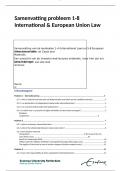Samenvatting
Summary Alle problemen + alle jurisprudentie + alle hoorcolleges + alle weblectures van Introduction to International and EU law (8,5 gehaald!)
- Instelling
- Erasmus Universiteit Rotterdam (EUR)
- Boek
- International Law
Deze samenvatting bevat echt letterlijk alles van heel dit vak dus veel info. Alle hoorcolleges, alle jurisprudentie, alle problemen en alle weblectures, dus je hoeft echt verder niks meer te doen behalve te leren als je dit hebt gekocht en dus ook geen boeken kopen. Ik heb een 9,2 gehaald, dus ik ...
[Meer zien]





